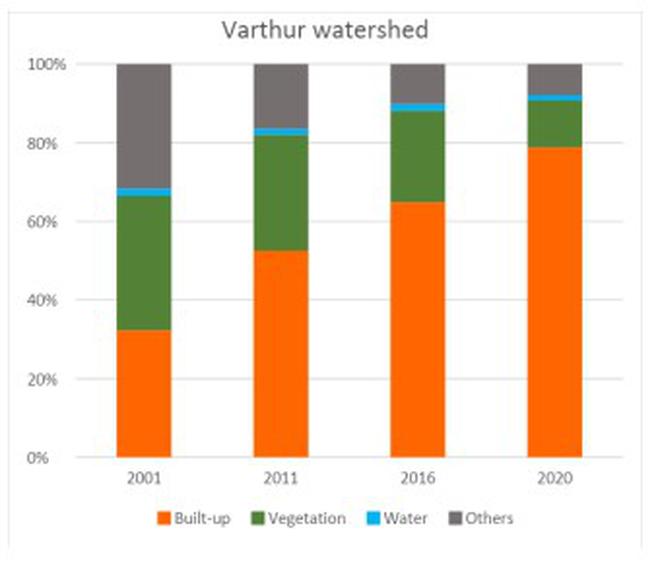In the past 15 years, India has seen several episodes of extreme rainfall in 24 hours: Mumbai received over 900mm of rain in 2005, Chennai had over 300mm in 2015, and now Bengaluru saw over 130mm. As climate change intensifies, we face the gloomy prospect of failure by governments, society and citizens across the world to limit the warming to 1.5°C above pre-industrial times.
Higher rates of evaporation from oceans, seas and land are pumping larger amounts of water vapour into the atmosphere in shorter periods of time. A warmer atmosphere is able to hold more water vapour, and this has led to an increase in heavy downpours. Further, with the warming of the Arabian Sea, cyclonic storms that were earlier largely associated with the Bay of Bengal and the eastern coast are now impacting cities and settlements on the western coast. In the coming decades, such extreme rain events are likely to increase.
Bengaluru had several advantages compared to many other Indian cities: a high elevation, an undulating topography, interconnected lakes, green spaces that helped soak rain, and rajakaluves (storm-water drains) that helped convey excess runoff. Most of these natural as well as human made advantages have been squandered away, both legally and illegally, exacerbating the city’s risk and vulnerability to floods.
We have drastically altered the hydrology of Bengaluru at various spatial scales, from local storm-water drains to entire basins and valleys. At the city scale, linear infrastructure such as the Outer Ring Road have disrupted natural hydrologic connectivity across the entire watershed. At local scales, piles of garbage in smaller drains kickstart a cascade of flood hazards.
The case of Varthur
Taking the case of Varthur, one of the lakes which was in the news during the floods, the built-up area in this catchment has increased from 32% to 79% between 2001 and 2020. Correspondingly, green cover in the catchment that can help soak rainfall shows a major decline – from 34% in 2001 to 12% in 2020.

As a result, impervious surfaces which have limited to zero ability to allow infiltration of water have increased from 86 sq. km to 213 sq. km. What this means is, even 0.01m (10mm) of rain on such surfaces would mean a runoff potential of 2.1 million cubic metres of water, and 100 mm (as what Bengaluru experienced recently) would mean a run off of a whopping 21 million cubic metres of water. All of this water needs to be conveyed through a network of drains to natural depressions and buffers around lakes to be able to store it. Even if a fraction of this runoff is not conveyed, it can cause immense damage as seen in the recent deluge.
The story is the same for the other lake catchments or watersheds in the east of Bengaluru. Bellandur catchment has witnessed a growth of built-up from 42% to 84% in the same period.
In recent years, the physical shrinkage of the lake is not by itself the issue. For instance, the surface area of waterbodies in the Varthur watershed declined from around 4.7 sq. km to 3.5 sq. km, suggesting that increased awareness and protection may have worked to limit big encroachments in recent years. However, lakes and natural depressions may not always fill up during many monsoons. This can give people who are unaware of hydrology a false sense of complacency and a temptation to build in that region, which will be disastrous when water eventually reaches these places to find no storage capacity left.
It is not only the physical quantity of the runoff that poses a hazard. When polluted drains and lakes overflow, the flood can pose a health hazard especially to vulnerable and exposed marginal communities living in informal settlements.
Urbanisation is a global and inevitable process, and with cities as engines of the economy, built-up areas will continue to grow. But we need to draw upon these experiences and the growing perils of climate change and extreme rain events and change course.
The way ahead
For one, a combination of deft, hard and well-designed civil and hydrologic re-engineering is essential to undo the damage from earlier developments, and to invest in ‘blue’ and ‘green’ infrastructure with accountable governance and management to make this successful.
On a city scale, the potential to restore hydrologic connectivity using mitigation measures across larger, linear hydrologic barriers such as the Outer Ring Road should be explored.
Locally, citizens, local ward officials and staff will need to work together to minimise dumping of solid waste and garbage in storm-water drains. It is important that restoring storm-water drains and hydrologic connectivity at local scales must be done justly, taking into account the impact on vulnerable sections of society and informal settlements. The unfortunate and insensitive case of pumping of water from a privileged community leading to flooding of homes of marginalised communities as seen in the recent floods is a case in point.
All remaining green spaces of the city, grasslands, campuses, and lakes must be seen as much needed lungs and shock absorbers of Bengaluru.
Early-warning systems using sensors across waterbodies and drains, and a network of communication for hotspots of emerging flood risk in the wet-season should be put in place.
In folklore, The Pied Piper of Hamelin was not paid his due for his services by those in charge despite his warnings and he took his revenge on the town in a terrible way. Perhaps it is not too late for us to recognise and respect the valuable ecosystem services of our water systems and green spaces. We need to heed the signals from our choked and encroached drains and lakes, ill designed infrastructure and missing pipes. Our ability to conserve our last remaining grasslands, lakes and green spaces and invest in hydrologically and ecologically informed infrastructure and buildings can lead to a better and safer Bengaluru.
The authors acknowledge Teja Malladi, Geospatial Lab, IIHS for his contribution to this article







